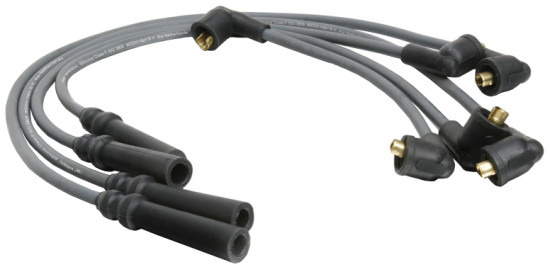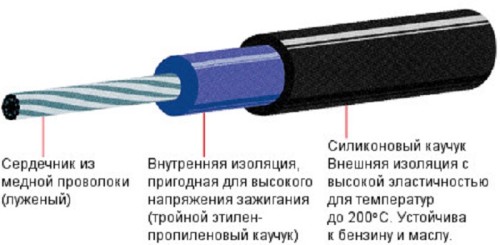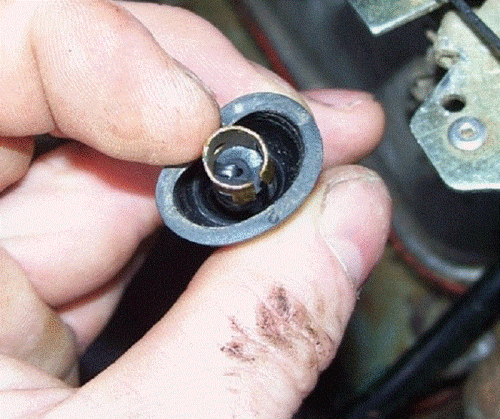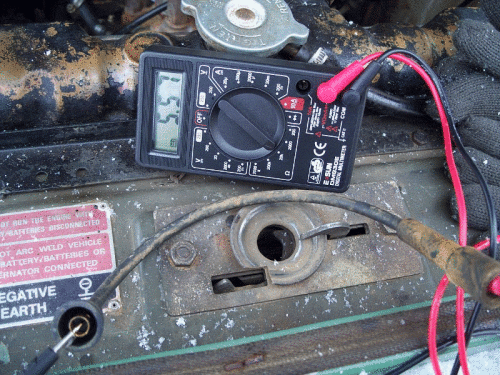High-voltage ignition wires are transmitted from the ignition coil electrical pulses for candles. They consist of a protective layer (isolation), conductive veins, protective caps and metal contacts. Today we will talk about possible malfunctions of high-voltage ignition wires and how to detect them.
Content
- High-voltage ignition wires, the most common faults
- High-voltage wires than threatening the gap of high-voltage wire
- Visual inspection of high-voltage wires, to pay attention to
- Resistance to high-voltage wires, check the resistance to the multimeter
- Professional tips when choosing high-voltage wires
High-voltage ignition wires, the most common faults
It is possible to understand that high-voltage wires are damaged or failed, on the following features:
- Increased fuel consumption.
- Reduced motor power.
- If the engine stalls.
- Unstable operation of the power unit on medium and high revs.
- Difficult launch of a motor in raw weather.

The main malfunctions of high-voltage wires - current leakage and electric circuit break.
Current leakage occurs as a result of a number of reasons:
- Resistance is too high.
- Contact malfunctions - in places connections with a coil or candle.
- Conducting lived broken.
- The insulating layer is damaged.
High-voltage wires than threatening the gap of high-voltage wire
The rupture of the electrical circuit is formed in the place where the metal contact of the wire and conductive lived, as well as other parts of the ignition system are connected. This can occur during the destruction and oxidation of the veins, removing the wire or poor connection of the findings of certain parts of the ignition system. In places where the compounds are impaired, heating and springs occur, which makes the situation even worse and can lead to burnout of the veins or metal contacts.
Visual inspection of high-voltage wires, to pay attention to
To begin with, it is necessary to inspect the wires for the presence of visible defects, for example, cracks, fractures, breakdowns, and so on.
- The visual inspection of high-voltage wires should be carried out indoors with muffled light.
- Next, open the car hood and turn the ignition motor.
- Now you should pay attention to the presence of breakdowns on the wires - if there is a spark on the wire, it must be replaced.
Resistance to high-voltage wires, check the resistance to the multimeter
The resistance of high-voltage wires should be measured using a multimeter.
- First we translate the computing device to the module mode.
- Then pull out the high-voltage wire from the first cylinder and the ignition module.
- Electrodes from multimeter Crepim to high-voltage wires.
- Check all the wires and observe the device performance.
All necessary information about the resistance is written on the insulation of the wire. When it normally works, the value of the measuring instrument should be 3.5-10 com. Indicators may differ, according to this satisfactory, they consider the scatter between them about 2-4 com. If the indicators are higher than optimal, it is necessary to replace high-voltage wires.
It is worth saying that experts are recommended to replace armored wires at once with a complete set, in order to avoid lining as a result of the incomprehension of the manufacturer and the wires themselves. Resistance indicators are capable of changing depending on the length of the wire, it is because of this between the fourth and first cylinders, deviations are visible. In addition, the resistance value in the armor guns from various manufacturers also have some differences.
Professional tips when choosing high-voltage wires
When choosing automotive armored wires, it is recommended to consider the type of conductive conductors and insulation material.
type of conductive core
Depending on the type of conductive conductors of the armor, can be divided into three groups:
- Wires with copper conductor. This type of automotive ignition armored aircraft is considered the traditional and simplest in the device. This carrier conductor with a copper stranded wire, which is covered with a layer of isolation. In such a drive, minimal resistance and a significant level of interference created by it during operation. Therefore, a fur-supplying resistors are included with these wires.
- Cables with non-metallic conductor and distributed low resistance, which consist of fiberglass, which is saturated with graphite and core, which is made of linen thread. The core is enveloped by a protective sheath with ferroplast, on top of which an intestine is applied from a metal wire. These wires have low resistance, so they require the installation of interference devices.

- Wires with non-metallic conductor and low distributed resistance that do not require the installation of resistors. Their conductive lives are made of polymers that are impregnated with the particle softeners of cotton yarn and fiberglass filaments sprinkled with graphite. As a rule, the conductive core is a non-metallic reinforcing braid, covered with a layer of isolation.
isolation material
Quite often, for insulation of armored wires, they will apply an inexpensive material - polychlorvinyl or polyvinyl chloride. The temperature range for which its work is calculated - 20 - +120 degrees Celsius.
More reliable is insulation with an elastomer, which is made on the basis of a copolymer of ethylene, propylene and a diene monomer. It has good dielectric properties and high resistance to the effect of aggressive liquids. In addition, it is wear-resistant and can operate at a temperature of -30 to +180 degrees Celsius.
Silicone is the most expensive insulating material for armored wires. It is characterized by high resistance to temperature drops -15 - +250, excellent insulating characteristics and unlimited service life. Such indicators made this inorganic polymer in the most popular and indispensable material in production.
It is worth noting that the insulation of the automotive ignition armored wires may be single-layer and multilayer. When choosing high-voltage wires, we advise you to choose silicone models with a large diameter of the core section. They do not need the installation of additional resistors, overwhelming and they have the best indicators of the current.
Related Materials
- Stove 2110, bad warm stove 2110, VAZ 2110 heating system, repairing the heating system VAZ 2110 with their own hands
- VAZ 2114 stove blows with cold air, stove 2114, bad warm stove VAZ 2114, device and repair of heating VAZ 2114 do-it-yourself, removing the stove VAZ 2114
- How to subdominize the car. How to put a jack. Types of jacks for cars.
- VAZ 2109 Fuse Block, VAZ 2109 Fuse Block Carburetor, VAZ 2109 Fuse Block Injector, Old VAZ 2109 Fuse Block, VAZ 2109 Fuse Block, VAZ Fuse Block 2109
- Car exhaust gas catalyst, faulty catalyst, pluses and cons of the catalyst, how to change the catalyst on the planeencitel
- Stove blowing cold air VAZ 2114, badly blowing the stove VAZ 2114, why badly blowing the stove VAZ 2114
- How to find out the owner of the car by the number of his car, check the car by the number of the traffic police machine, check the car by the state number of the car for free
- How to choose Used tires, Useful Tips
- Winter car road, pressure in passenger car tires in winter, good battery for the car in winter, whether to warm the car in winter
- In winter, the car is poorly started. How to make a car in winter, do you need to warm up the car in winter, useful tips
- Economy fuel consumption machines, the most economical car consumption
- Tires brands for passenger cars, labeling of car tire labeling, residual passenger car tire protector, how to pick a tire on a car brand, car tire tread pattern
- Working transmission operation, mechanical gearbox clutch work, driving with manual gearbox, useful tips
- Rear beam Peugeot 206 sedan, rear beam device Peugeot 206. Rear beam Peugeot 206 Malfunction, repair of the rear beam Peugeot 206
- Diesel fuel in winter, additive for diesel fuel in winter, how to choose the best diesel fuel
- Diesel winter does not start. How to start diesel in winter, heating diesel in winter.
- Japanese bridgestone tires, winter studded bridgestone tires, bridgestone tires brand
- Tire marking decoding for passenger cars, labeling wheels, how to choose the right tires on the disks
- Diesel engine in winter, launch of the diesel engine in winter, what oil to fill in a diesel engine in winter, useful tips
- LED backlight of the car, the backlight of the bottom of the car, the backlight of the legs in the car, the backlight in the door of the car, the backlight of the car is fine
- Recovered tires, bus tire, restored tire protector, can I use them
- Choose winter tires, which is a winter tires, which pressure in winter tires should be marked with winter tires, how to choose the right winter tires, the best winter tires 2019
- Steering rail rail, knock of steering rack, reasons for the knock and repair of the steering rack do it yourself
- Cameless car tires, a set for repair of tubeless tires, repair of the cannon-free tire do it yourself
- Russian tires, Russian tires Winter, Russian All-season tires, Voronezh AMTEL tires, Tires "Matador Omsk Tire", Kama-tires are world-class bus
- How to open a car without a key. Lost the key from the car what to do, the key from the car inside the car
- Silent tires, quiet winter tires, quiet studded bus, which tires to choose, overview tires
- Tires and safety, safety of the bus, why it is necessary to constantly monitor car tires
- Rules of safe driving of the car in the rain and slush, safe driving of the car for beginners
- Rust converter which is better for cars, rust converters to choose how to use rust transducer, professionals
- Polishing the body of the car do it yourself, how to choose a polishing paste, useful tips
- Engine durability, engine life, how to extend engine life
- Knock in the car. Knock when moving the car. What can knock in the car. How to determine the cause of the knock.
- ABS car, what is ABS car, ABS system malfunction, ABS diagnostics
- Overtaking a car when you can start overtaking a car, rules of traffic rules
- Fuel pump VAZ 2110, VAZ 2110 gas station scheme, VAZ 2110 fuel pump device, VAZ 2110 gas station repair,
- Automotive antennas for radio, automotive antenna device, car antenna do it yourself
- Front suspension Kalina, device front suspension Kalina, knock in front suspension Kalina, repair of front suspension Kalina
- Shock absorber Oil, best oil shock absorbers, pumping oil shock absorbers, how to properly pump oil shock absorber
- Clutch malfunctions, touches clutch, causes a clutch malfunction, how to eliminate










Comments